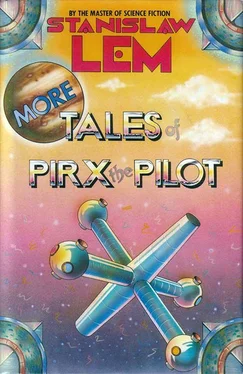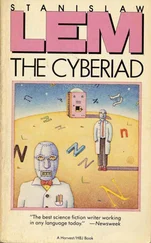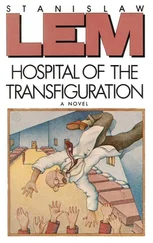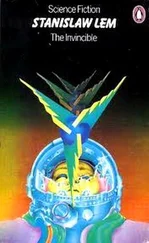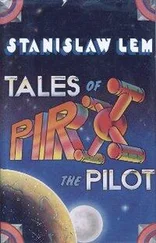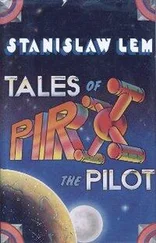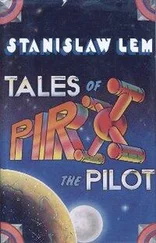“ARIEL”—rasped the husky voice—“COURSE ALTERATION. AWAY FROM METEORITE. FULL POWER AHEAD IN THE AXIS! ATTENTION! FULL THRUST!”
It was the computer’s voice. Then another—this one human—yelled something in the background. Pirx had correctly diagnosed the change in exhaust: the reactor’s full thrust had taken over from the boron, and the giant spaceship, as if arrested by the powerful blow of an invisible fist, vibrating in all its joints, stopped—or so it seemed to those looking on—in the thin air, a mere four or five kilometers above the cosmodrome’s shield. To arrest a hundred-thousand-ton mass before reversing, without decelerating first, was unheard of, a maneuver in violation of every rule and regulation, defying all the basics of astronavigation. Pirx saw the giant cylinder’s hull in foreshortened perspective. The ship was losing its vertical trim; it was listing. Ever so slowly, it began to right itself, then tilted the other way, like a giant pendulum, resulting in an even steeper inclination of the quarter-mile-long hull. At such low velocity, a loss of stability of this amplitude was beyond correction. Only in those seconds did Pirx hear the chief controller scream:
“Ariel, Ariel! What are you doing? What’s happening up there?!”
Pirx, standing by a parallel, vacant terminal, shouted into the mike:
“KLYNE! SWITCH TO MANUAL OVERRIDE!!! TO MANUAL FOR LANDING!!! MANUAL!!!”
Just then they were jolted by a thunderous roar—the Ariel’s delayed sound wave, unremitting, prolonged. How fast it had all happened! A concerted cry went up from the windows. The controllers jumped up from their consoles.
The Ariel plummeted like a stone, recklessly strewing the atmosphere with swirls of exhaust flare, rotating slowly, corpselike, an enormous iron tower flung from the sky onto dirty desert dunes. All stood nailed to the floor in a hollow, horrific silence fraught with impotence; the loudspeaker grated, crackled, rumbled with the distant clamor—like the roar of the sea—while a refulgent, white, incredibly long cylinder shot down with accelerated speed, seemingly aimed at the control tower. Pirx’s neighbor let out a groan. Instinctively everyone ducked.
The hull slammed into one of the shield’s low outer walls, halved, and, breaking up with an eerie slowness in a shower of fragments, buried itself in the sand; a ten-story cloud shot up, boomed, and rained stitches of fire. Above the curtain of ejected sand loomed the still blindingly white nose section, which, truncated from the rest, traversed the air a few hundred meters; then one, two, three powerful thuds with the force of earthquake tremors. The whole building heaved, rose and fell like a skiff on a wave. Then, in a hellish racket of cracking iron, everything was blotted out by a brownish-black wall of smoke and dust. Even as they raced downstairs to the airlock, Pirx, one of the first to suit up, had no doubts: in such a collision, there could be no survivors.
Soon they were running, buffeted by the gale winds; from far off, from the direction of the “bell,” the first of the caterpillar vehicles and hovercrafts were already on the move. But there was no reason to hurry. Pirx didn’t know how or when he returned to the control tower—the image of the crater and the crushed hull still in his dazed eyes—and only at the sight of his own suddenly grayed, somewhat shrunken face in a wall mirror did he come to.
By afternoon, a committee of experts had been set up to investigate the causes of the crash. Work crews with excavators and cranes were still clearing away the wreckage of the giant vehicle, and had yet to reach the deeply buried cockpit containing the automatic controls, when a team of specialists was bused over from Syrtis Major—in one of those quaint little helicopters with huge propellers, custom-designed for flight in the Martian air. Pirx kept out of the way and didn’t ask questions, knowing only too well that the case bordered on the unsolvable. During a routine landing, with all its hallowed sequences and clockwork programming, for no apparent reason the Ariel’s primary computer had shut down the boron power, signaled a residual meteorite alarm, and initiated an escape maneuver at full thrust; the ship’s stability, once lost during this neck-breaking action, was never regained. It was an event unprecedented in the history of astronavigation, and every plausible hypothesis—a computer failure, a glitch, a short in one of the circuits—appeared highly improbable, because there was not one but two programs for lift-off and landing, safeguarded by so many back-up systems as to make sabotage a more likely cause.
He puzzled over the incident in the little cubicle that Seyn had put at his disposal the night before, deliberately laying low so as not to intrude, especially since he was scheduled to lift off within the next twenty-four hours; but he couldn’t come up with anything, or at least not with anything he could report to the committee. He wasn’t forgotten, though; a few minutes before one in the afternoon, Seyn paid him a visit. Waiting in the corridor was Romani; Pirx, on his way out, didn’t recognize him at first. The coordinator of the Agathodaemon complex could have passed for one of the mechanics: he wore a pair of sooty, grease-stained overalls, his face was drawn, the left corner of his mouth twitched, and only his voice had a familiar ring. On behalf of the committee, of which he was a member, he asked Pirx to postpone the Cuivier’s lift-off.
“Sure thing.” Pirx, a trifle stunned, tried to regain his composure. “I just need clearance from Base.”
“Leave that to us.”
Nothing more was said, and the three of them marched over to the main “bubble,” where, inside the long, squat command HQ, sat some twenty or more experts—a few of whom were based locally, the majority having flown over from Syrtis Major. It was lunchtime, but since every second was precious, they were served a cold meal from the cafeteria. Over tea and paper plates, which lent the proceedings a strangely casual, even festive air, the session got under way. The chairman, Engineer Hoyster, called first on Pirx to describe the abortive landing, and Pirx could easily guess why. Belonging neither to the ground-control team nor to Agathodaemon’s crew, he was the only unbiased witness present. When he reached the point of his own personal intervention, Hoyster interrupted him.
“So you wanted Klyne to shift from automatic to manual override?”
“Yes.”
“Why, may I ask?”
“I figured it was his only chance,” Pirx answered without hesitation.
“Right. And you didn’t foresee that the shift to manual would mean a loss of stability?”
“It was already lost. This can be checked; we do have the tapes.”
“Naturally. We just wanted to get a general picture. What’s your own guess?”
“As to the cause?”
“Yes. For the moment we’re just piecing together the facts. Nothing you say will be binding; any hypothesis, however shaky, may prove valuable.”
“I see. My guess is that something went haywire with the computer. What, or even how, I couldn’t say. I wouldn’t have believed it myself if I hadn’t witnessed it with my own eyes and ears. The computer aborted the maneuver and signaled a meteorite alert. It sounded like ‘Meteorites—attention, full power ahead in the axis.’ But with no meteorites around…” Pirx shrugged.
“The Ariel was an advanced AIBM 09,” observed Boulder, an electronics engineer with whom Pirx had rubbed elbows at Syrtis Major.
Pirx nodded.
“I know. That’s why I said I wouldn’t have believed it if I hadn’t seen it with my own eyes. But it did happen.”
Читать дальше
